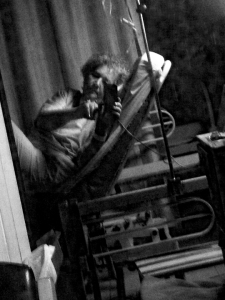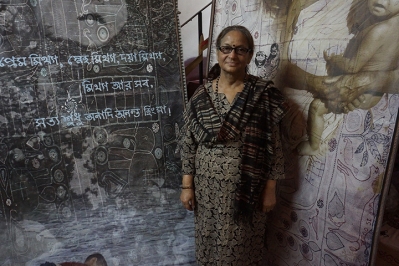This is the second time I’ve made tea for an Indian friend using a kitchen timer. My tendency is to set the teapot on the stove and to walk away – there are so many other things to do that need to get done! Eventually, I either remember, albeit too late as the water has already boiled, spoiling “a perfect cup of tea,” or the water has almost boiled off.
My kitchen here has one of those amazingly powerful 2-burner propane cook stoves found in every Indian kitchen. It boils water 10x faster than my fancy $3K Thermador Pro stove back home. So, as per my tendency, I’d always over-boil the tea water, and similarly, over-steep the tea. Finding a kitchen timer in the shops proved impossible last year. This time I brought my own timekeeper with me.
 So, after pouring my almost-boiled water into the teapot, I wound the timer to a perfect 5 minutes. It started ticking off the minutes – (I like a perfectly brewed 5-minute pot of Darjeeling tea.) My friend looked at the blue plastic timepiece and asked: “What is this?” “A timer,” I said. “What is it for?” “To time something… like tea.” I replied. “Oh, this is such a non-Indian concept,” my first friend said. “So, how do you know when the tea is ready?” I asked. “Oh, you just know” my friend said. When the exact same conversation (word-for-word) took place 2 days later, with a different friend, I knew I was on to something.
So, after pouring my almost-boiled water into the teapot, I wound the timer to a perfect 5 minutes. It started ticking off the minutes – (I like a perfectly brewed 5-minute pot of Darjeeling tea.) My friend looked at the blue plastic timepiece and asked: “What is this?” “A timer,” I said. “What is it for?” “To time something… like tea.” I replied. “Oh, this is such a non-Indian concept,” my first friend said. “So, how do you know when the tea is ready?” I asked. “Oh, you just know” my friend said. When the exact same conversation (word-for-word) took place 2 days later, with a different friend, I knew I was on to something.
We are all obsessed with time – there is never enough of it. In our modern culture we try to cram more and more into a day – “so much to do, so little time.” Soon I/we find ourselves in our mid thirties – oh my goodness, if I want to have children, I better do it now, or I’ll run out of time. Then I/we find ourselves in our mid-sixties – oh my goodness, I haven’t done anything with my life. The twenty-something immortality concept I’ve been living by all these years comes crashing to the floor.
I recently saw the film Interstellar. Amazing film, on so many levels, not the least of which, the way it dealt with the concept of time. [Spoiler Alert]. The “behind the bookcase scene” where Matthew McConaughey is desperately trying to communicate with his daughter, in the present, but it’s really the past, because the messages are from the past. But it’s the present, and time is running out, and he needs to get his message through, but it all has already happened in the future… behind him are pulsating colored bands of light – the stretching of time perhaps? I sat on the edge of my seat, mesmerized not only by the visual elements, but also about how Christopher and Jonathan Nolan had dealt with the bending of time.
On the plane to India I watched Lucy, also an incredible film that challenges the concept of time and existence itself. For example, if you speed up a moving object to the speed where the object is going so fast it disappears from sight, does it still exist, or did it ever exist? A similar concept to the “tree in the forest” thing, but much more interesting.
So what does all this have to do with brewing a perfect 5-minute pot of Darjeeling tea? Nothing and everything. I’ve written before about how India makes me look at the world differently, how it makes me confront my values, my pre-conceived notions about just about everything. It makes me think in ways other environments have not been able to do – things are so raw here, everything is so in-your-face – the colors, the smells, the sounds, the poverty, the wealth, the art, the food.
So, why is a kitchen timer not an Indian concept?
My friend Jeet says it’s because time is a Western concept. Hindus have no romance with time – Hindus are like Jazz, Westerners are like Classical Music. Hindus believe time is eternal (hence reincarnation?) But Hindus also wear watches, turn their TVs on to watch specific shows, get their kids to school at the appointed hour, and run successful businesses, all dependent on time.
We were in Delhi recently, staying at a wonderful B&B. They had a full kitchen so every morning I made myself tea. My timer was a fixture in the kitchen. I noticed that every time Dilip, the house manager, came into the flat, he’d pick up the timer & examine it carefully. He asked me what it was and, as usual, I explained. “Oh,” he said, nodding his head, deep in thought.
I explained that I had brought it from the U.S. because it was impossible to find here in India. I told him how I’d tried to explain the item to shopkeepers: “… see, it’s this clock that you wind, and it goes tic..tic…tic… boing!” At which point I’d throw up my arms to emphasize the “boing” thing. This became the subject of much laughter in the weeks to come as I heard him explain to others the workings of the timer, in Hindi, each time throwing up his arms at the “boing” moment. Then they’d double over in laughter.
During the last week, I asked Dilip if he’d like to have the timer. “Yes,” he said, “I think it would be quite useful.” “Then I’ll gift it to you. When you use it perhaps you’ll remember the slightly crazy white lady who delighted in explaining the concept of a timer to Indian shopkeepers.”














 Then there was the man on the other side of the curtain. He had been coming to the hospital since August, every month for 4 days of chemo. It was very evident that he had lost a lot of weight. His skin was pasty, his voice hoarse, he did not have much hair. He always cheerfully greeted me as I passed his bed, heading to our shared bathroom. He always inquired about my health. What right did I have to feel so sorry for myself, to be so miserable, when my situation was temporary and his so permanent and devastating? I had such trouble getting beyond the “temporary” – everything seemed to catapult into the “forever.”
Then there was the man on the other side of the curtain. He had been coming to the hospital since August, every month for 4 days of chemo. It was very evident that he had lost a lot of weight. His skin was pasty, his voice hoarse, he did not have much hair. He always cheerfully greeted me as I passed his bed, heading to our shared bathroom. He always inquired about my health. What right did I have to feel so sorry for myself, to be so miserable, when my situation was temporary and his so permanent and devastating? I had such trouble getting beyond the “temporary” – everything seemed to catapult into the “forever.” hospitals in Delhi. I thought about the thousands of people in Delhi, in Kolkata, in Mumbai, who live on the street, who have no access to this care. I thought about how blessed I was to have a husband who would pull me out of depression and make me look at what I had in front of me, to make me understand that the “forever” is not forever.
hospitals in Delhi. I thought about the thousands of people in Delhi, in Kolkata, in Mumbai, who live on the street, who have no access to this care. I thought about how blessed I was to have a husband who would pull me out of depression and make me look at what I had in front of me, to make me understand that the “forever” is not forever.







 Everyone asked her where her “attendant” was and were shocked to learn she was by herself. The tradition is for a family member to sleep at the hospital—they even set up a couch, bring food, blankets, etc. In the poorer wards, families roll our rugs and sleep on the floor. Nurses had a hard time understanding that I was working. Eventually, I ended up sleeping on the couch too.
Everyone asked her where her “attendant” was and were shocked to learn she was by herself. The tradition is for a family member to sleep at the hospital—they even set up a couch, bring food, blankets, etc. In the poorer wards, families roll our rugs and sleep on the floor. Nurses had a hard time understanding that I was working. Eventually, I ended up sleeping on the couch too.
 So, after pouring my almost-boiled water into the teapot, I wound the timer to a perfect 5 minutes. It started ticking off the minutes – (I like a perfectly brewed 5-minute pot of Darjeeling tea.) My friend looked at the blue plastic timepiece and asked: “What is this?” “A timer,” I said. “What is it for?” “To time something… like tea.” I replied. “Oh, this is such a non-Indian concept,” my first friend said. “So, how do you know when the tea is ready?” I asked. “Oh, you just know” my friend said. When the exact same conversation (word-for-word) took place 2 days later, with a different friend, I knew I was on to something.
So, after pouring my almost-boiled water into the teapot, I wound the timer to a perfect 5 minutes. It started ticking off the minutes – (I like a perfectly brewed 5-minute pot of Darjeeling tea.) My friend looked at the blue plastic timepiece and asked: “What is this?” “A timer,” I said. “What is it for?” “To time something… like tea.” I replied. “Oh, this is such a non-Indian concept,” my first friend said. “So, how do you know when the tea is ready?” I asked. “Oh, you just know” my friend said. When the exact same conversation (word-for-word) took place 2 days later, with a different friend, I knew I was on to something.





















